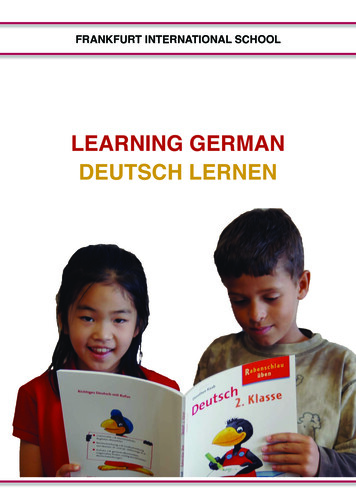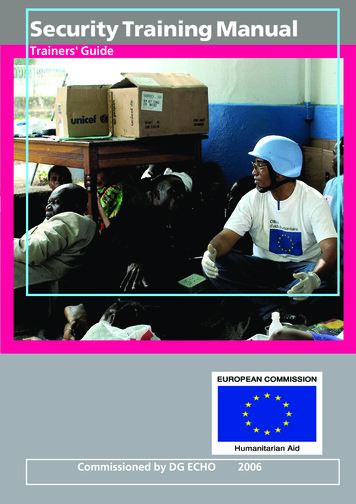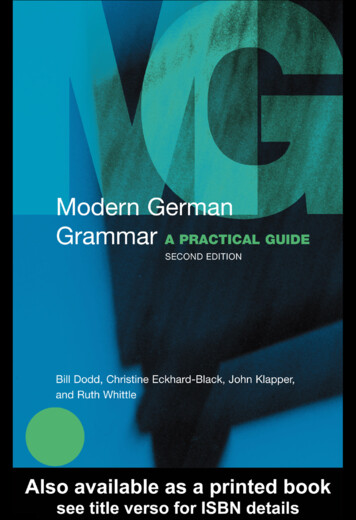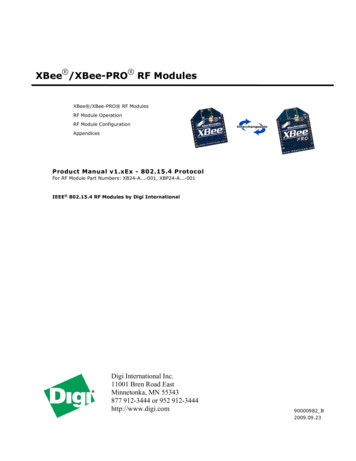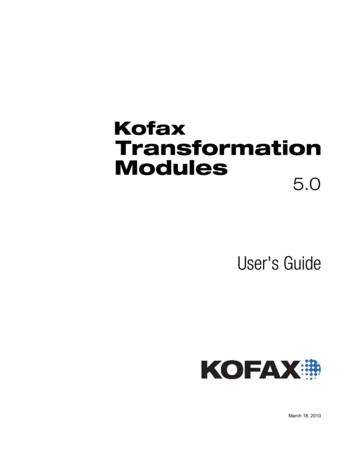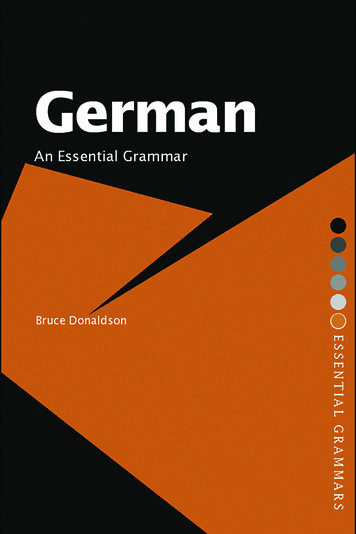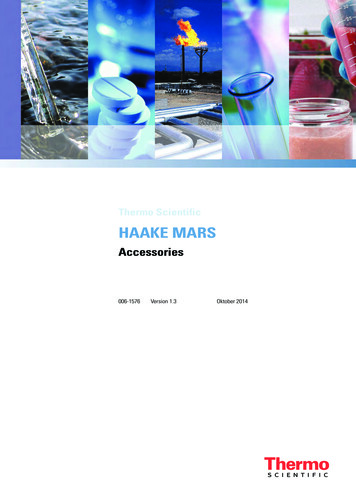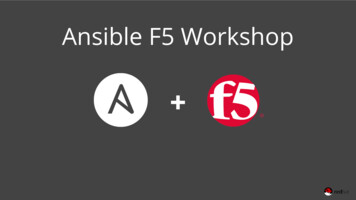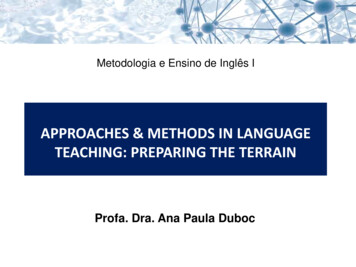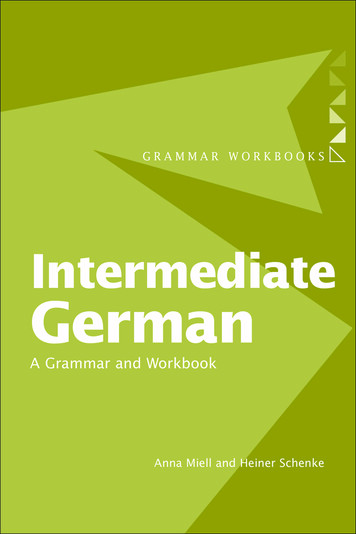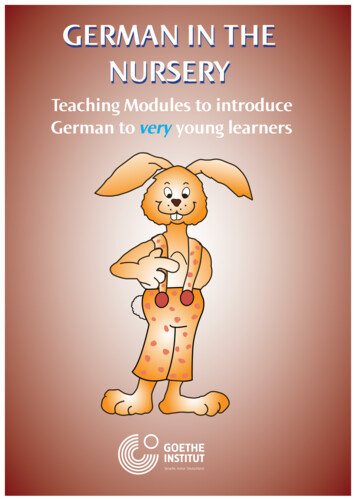
Transcription
GERMAN IN THENURSERYTeaching Modules to introduceGerman to very young learners
CURRENT SITUATIONAND REASONS FOREARLY FOREIGNLANGUAGE LEARNINGThere is a worldwide tendency to start foreign language learning muchearlier than 15 years ago. Research has shown that children learn a newlanguage with enthusiasm, are able to develop elementary communicativecompetence and language awareness.Early second language learning builds on children’s curiosity, eagerness forknowledge, need to communicate and the willingness and ability to imitateand articulate words and phrases. Furthermore, children benefit from anadditional opportunity to progress ïn a multifunctional manner. In this waya positive attitude towards foreign language and culture is promoted. Theholistic approach has a positive effect on learning in general.TEACHING STRATEGIES Skills teachingWhen talking about language skills, the basic ones are listening, speaking,writing and reading. The last two mentioned are at this stage of languageteaching not relevant. However, other, more socially based have beenidentified more recently such as summarising, describing, and narrating.Children are able to work on these skills with the support of visual aids.Code - switchingChanging between languages at some point in a sentence, is acommonly used communication strategy among language learners andbilinguals. It has the advantage that it encourages fluency development andmotivation and a sense of accomplishment.Sandwich techniqueIs the oral insertion of an idiomatic translation in the mother tonguebetween an unknown phrase in the learned language and its repetition, inorder to convey meaning as rapidly and completely as possible. The mothertongue equivalent can be given almost as an aside, with a slight break in theflow of speech to mark it as an intruder.Teacher: Hört gut zu! - listen carefully! - Hört gut zu!Total physical responseChildren respond to commands which require physical movement. Thisapproach allows children to gain confidence in listening and show theirunderstanding.AIM OF THE COURSE To introduce children to aspects of German culture. To focus on developing listening and speaking skills. To raise language awareness. To show it is fun to learn a foreign language.1
FOR THE CLASSROOM Material A poly pocket for each child to collect their drawings and sheets and asmall set of coloured pencils. Rubber stamps in different colours, shapes and motifs. Children get a stamp for completion of the activity sheets.Resources for Teachers A hand puppet (rabbit) which is called Hans Hase gets introduced in thefirst lesson and should play a role in each lesson. He only speaks andunderstands German. The teacher plays the role of a translator betweenthe children and Hans Hase. A bag ‘Wühlsack’ which can be used to introduce new vocabulary informs of objects, flashcards or pictures. A magic blanket ‘Zauberdecke’ under which objects can be hidden orappear and disappear.German language cornerA designated wall in the nursery can be used as a visual book of record forthe children, staff and parents. Pictures can be displayed which are linked tothe German class.Material boxA box with resources, props and teaching aids as well as supplementaryresources to support the core teaching units and follow-up activities.Board games - give the children the opportunity to apply the languagelinked to a specific topic and phrases like ‘Your turn’ can be practiced inGerman.Books - captivate children’s imagination and provide a structured andembedded language input.CDs - German children’s songs: Music can play a vital part in languagelearning as both music and language are associated with emotions.Whenever possible use gestures and movements to accompany the songs.2
RECOMMENDATIONSThe following recommendations can be adapted and put in useaccording to group sizes in the nursery. The circle time activities alwaysprovide the possibility of follow up language activities in smaller groups.Regular weekly slots for German in circle time are the starting point forthe children’s language learning in nursery. Welcome song Chit chats with Hans Hase who is acting shy or cheeky.He could bring something special from Germany or somethingof interest for German in circle time. Teacher introduces three to four new German words by usingreal objects, flashcards or pictures. The children get the opportunity to show their understandingof the German words by doing the right action. The language task should enable the children to use only thenew words Song, rhyme or riddle which is linked to the introduced words. It is the teacher’s or pupil’s decision when and how they wantto continue working on the language topic; later in the week, insmall groups, pairs or individually.A choice of activity sheets are provided for each topic. Children choose a picture to put up on the wall in the Germanlanguage corner which is linked to the new words in German. Goodbye song and saying goodbye to Hans Hase and thechildren. Children get a rubber stamp for completion of an activity sheet.3
WELCOME SONGThe songs are accompanied by appropriate movements, i.e. waving and pointing.There is no fixed melody for the songs - choose one which you or the children likebest. After the welcome song the children are greeted individually. Vary the greetingsand shake hands. It is a cultural custom to shake hands when greeting people.Hallo ., Guten Tag ., (for late morning or afternoon).Guten Morgen., (for early morning).12Guten Morgen, guten Morgen GutenMorgen, guten Morgenwir winken uns zu. wir klatschen uns zu.Guten Morgen, guten Morgen Guten Morgen, guten Morgenerst ich und dann du. erst ich und dann du.3Guten Morgen, guten Morgen GutenMorgen, guten Morgen4wir stehn auf einem Bein. wir drehen uns um.Guten Morgen, guten Morgen Guten Morgen, guten Morgenerst ich und dann du. erst ich und dann du.1Good morning, Good morning(or later - Good day, )We all wave hello (childrenwave)Good morning, good morningFrom me to you2Good morning, good morningWe all clap hello (children clap)Good morning, good morningFrom me to you3We all step up (children stand onone leg)4We all turn round (children turnaround)GOODBYE SONGGeht die Gruppe nun zu Ende,geben wir uns jetzt die Händedu und ich, ich und du,winken uns zum Abschied zu.4Now we all are going homeWe shake each others’ hands(children shake hands)You and me, Me and youWe all wave bye bye! (children wave)
TOPIC 1Colours and German SymbolsOutcomes To get to know Hans Hase To learn greetings in German To get to know colours in German To get to know a rhyme in German To get to know the colours of the German flag To get to know the traffic light men in Germany5
6Colour andGermansymbolsColoursTOPIC 1Teacher talks to Hans Hase andincludes the childrenHans Hase hands out scarves indifferent colours (red, yellow, green,black, blue)Colour game:Teacher calls out a colour - childrenholding the scarf with the namedcolour wave the scarf above theirheads.Teacher introduces HansHaseIntroducing coloursReproducing newvocabularyRed and green trafficlight menChildren and teacher shake handsTeacher greets childrenindividuallyTeacher shows pictures of the greenand red traffic light men and showsthe movements of walking andstanding. Children walk about andstop when the teacher says rotand start walking again when theteacher says grün.Hans Hase does magic:He says a spell and the childrenholding the scarf with the colourwhich was mentioned in the spellmake their scarves disappear behindtheir back.Singing, pointing, waving, clappingACTIVITIESWelcome songDESCRIPTIONCircleGrün (go).Rot (stop).HokuspokusFidibus:Rot ist weg.Schwarz ist weg.Gelb ist weg.Grün ist weg.Blau ist weg.Rot für .Gelb für .Grün für .Schwarz für .Blau für .CircleCircleCircleHand puppetscarvesDifferentcolouredscarvesHand puppetSongMATERIALRESOURCESGame: Farben ratenGuess the colourTwo children sit with their backs toeach other in the middle of a circle.The one child needs to guess thecolour of the scarf the other childhas chosen.Game: Stille PostPass the messageThe first player whispers the nameof a colour to the next player. Eachplayer passes the word on. The lastplayer announces the colour orpoints to the scarf in that colour.SUPPLEMENTARYRESOURCESThe ‘traffic men’ areLaminatedGame: Fliegenklatschesymbols from the former pictures of theFly swartGDR and are polulartraffic menFour children get a fly swart andwith people from allfour differently coloured circles areparts of Germany andlaid out in the middle. The teacherare a popular souvenircalls a colour and the children hitwith visitors to Berlin.the right coloured circle.Colours in GermanShaking handsGreetings inGermanORGANISATION CULTURALINPUTDas ist Hans Hase. CircleHalloGuten Tag./Guten Morgen.Song textLANGUAGE
7Pictures, Germanlanguage corner.Goodbye songSong textTschüss, aufWiedersehenTschüss /aufWiedersehen HansHase.Child or teacher puts up a picture ofthe traffic light menSinging, waving, pointingTo say goodbye toHans HaseLanguage cornerGoodbye songTo say goodbyein GermanActivity sheet 3rhymeChildren colour in the sun, the sky,the grass and a rose.Hand puppetActivity sheet 2Colour rhymeGerman FlagActivity 3Das ist blau und das istweiß.Blau oder weiß?Children colour in the German andScottish flag.German and ScottishflagActivity sheet lyORGANISATION CULTURALINPUTDas ist grün und dasist rot.Grün oder rot?LANGUAGEChildren colour in the red and greentraffic light men.ACTIVITIESTraffic light menDESCRIPTIONActivity 1Follow upactivities:TOPIC 1At the end of circle timethe children get a sticker ofthe German flag to put ontheir poly pockets.German and Scottish flag:Hans Hase shows theGerman and the Scottish flag.Children gather scarvesto make the German andScottish flag.Schwarz, rot, gelbBlau,weißSUPPLEMENTARYRESOURCES
Das AmpelmännchenThe German Traffic Light MenDas Ampelmännchen (little traffic light man, pl. die Ampelmännchen) is the symbolic personshown on traffic light at pedestrian crossing.Prior to the German reunification and the fall of the wall in 1989/90 the two German stateshad different designs for the traffic light men. The Ampelmännchen in West Germany was ageneric human figure and the Ampelmännchen in East Germany was a male figure wearinga hat. The Ampelmännchen was a beloved symbol in Eastern Germany and has now theprivileged status of being one of the few features of communist East Germany to have survivedthe end of the Iron Curtain with his popularity unscathed. After the fall of the Berlin wall theEast German Ampelmännchen acquired cult status and became a popular souvenir item.A more childlike explanation could be:In Scotland, at road crossings, we have red and green men to tell us when it is safe to cross thestreet. In Germany they are very fond of their red and green men who wear little hats. Theyoften use them on T shirts, mugs and other souvenir items. http://ampelmannshop.com/8
Activity Sheet 1aTask: Colour in the traffic lightsman in green.9
Activity Sheet 1bTask: Colour in the traffic lightsman in red.10
Die Nationalfahne in Deutschland und in SchottlandThe German and the Scottish flagThe German flag, (die Fahne or die Nationalfahne), has three colour bands - Red,black and gold (yellow).The flag was first adopted as the national flag about 100 years ago, but the coloursof the flag have been associated with German kings and states since the MiddleAges. It has been said that the red stands for courage, the black for determinationand the gold for generosityOur Scottish flag, the Saltire, is blue with a white cross from corner to corner. Itforms part of the British Union Jack flag. The Saltire dates back to the Middle Agesand is believed to be the oldest national flag in Europe.”11
Activity Sheet 2Task: Colour in the German and Scottish flags.12
Teacher says rhyme andchildren join in.Activity Sheet 313Reim:Blau ist der Himmel,gelb ist die Sonne,rot ist die Rose,grün ist das Gras,so einfach ist dasRhyme:Blue is the sky,yellow is the sun,green is the grass,red is the roseso easy it goes.Task: Colour in - usethe rhyme as yourguide.
TOPIC 2Parts of the BodyOutcomes To get to know the parts of the body in German To become familiar with the Berlin Coat of Arms To compare the Berlin Coat of Arms with the GlasgowCoat of Arms To learn a children’s song in German14
15TeddyBody PartsTOPIC 2Teacher or Hans Haseintroduce Oskar theTeddy bear fromGermany. Oskar is verygood at shaking hishead, ear, leg, arm andtummy and likes toshow off his skills.Teacher talks to the teddy bear andtells him to shake his arm, his leg.der Bauch! (belly)das Ohr! (ear)der Kopf! (head)das Bein! (leg)der Arm! (arm)Hallo KinderHallo Hans HaseHans Hase says hello to thechildren.Hans Hase greetschildrenIntroducing vocabularyfor body parts.Guten Tag.Guten Morgen.Children and teacher shake hands.Teacher greets childrenindividuallySong textLANGUAGESinging, pointing, waving, clapping.ACTIVITIESWelcome songDESCRIPTIONCircleCircleCircleShaking handsGreetings inGermanORGANISATION CULTURALINPUTTeddyHand puppet(Hans Hase)Welcome songMATERIALRESOURCESTeacher calls out a specific partof the body in German and thechildren shake the named partof their body.Speeding up the activity canincrease the fun!Game: Shake your bodySUPPLEMENTARYRESOURCES
16TOPIC 2The children close their eyes andHans Hase says a spell taking onebody part away. Children open theireyes and say which part is missing.Hans Hase does magic:Hokuspokus Fidibus.CircleCircledas Beinder Armder Kopfder Bauchdas OhrTo put the puzzle together:teacher asks for individual partsand also points to them. Thechildren piece the puzzle togetherin the circle.Applying vocabularyCircleDer Kopf fürFatima,der Arm für (2x)der Bauch für .das Bein für (2x)das Ohr für (2x)Each child gets a piece of the Teddypuzzle, showing a part of the body.Magic spell inGermanORGANISATION CULTURALINPUTReproducingvocabulary by using aTeddy Bear puzzleLANGUAGEACTIVITIESDESCRIPTIONZaubersack (bag)Laminatedpuzzle pieces(Appendix1)MATERIALRESOURCESChildren sit in a circle with onechild standing in the middle.There is one chair less than thenumber of children. Hand outthe body part pieces in pairs.Always two children shouldhave the same body part.Teacher calls out “Bein”. Thetwo children who have the leghave to swap seats. The childin the middle has to try to geta seat. The calling out of thebody part has to be supportedby pointing to the part.Game: Fruit SaladIn bigger groups two sets ofthe same puzzle could be usedto involve all the children.SUPPLEMENTARYRESOURCES
17Activity 2Activity 1Follow-upactivities:CultureTOPIC 2Coat of Arms of BerlinTeddy bearCoat of Arms of Berlinportraying a bear.DESCRIPTIONdie Krallen (claws) - rotdie Zunge (tongue) - rotder Kopf, die Ohren, der Bauch,die Arme, die Beine - schwarzdie Krone (crown) - gelbChildren colour in the emblem.SmallgroupSmallgroupCircleORGANISATIONdie Ohren - braun/rotder Kopf - braunder Bauch - blaudie Beine, die Arme - braun/rotThis bear is a bearand not a teddy bear.It has a red tongueand red claws. Itwears a crown. Itcomes from Berlin.Berlin is a big city inGermany.LANGUAGEChildren colour in the teddy bearcopying the colours on the sheet.Teacher shows picture of theemblem. The conversation isconducted in English.ACTIVITIESCoat of Arms ofBerlinCoat of Arms ofBerlin.CULTURALINPUTActivitysheet 2Activitysheet 1Picture ofemblem(Appendix 2)MATERIALRESOURCESIn the follow-up activity thecoat of arms of Glasgow couldbe discussed. (Appendix 3)SUPPLEMENTARYRESOURCES
18Song textTschüss Hans Hase.Singing, waving, pointing.To say goodbye to Hans Hase.CircleCircleSmallgroupTo say goodbyein GermanORGANISATION CULTURALINPUTSongtextKopf, Schultern, Knieund Zehen, Knie undZehen.Augen, Ohren, Mundund Nase, Kopf,Schultern, Knie undZehen, Knie undZehen.die Haare - hairdie Augen - eyesdie Nase - noseder Mund - mouthGoodbye songTeacher and children name partsof the body while the drawing isdone.Child lies on paper and either theteacher or another child drawaround him\her. The shape can becut out and coloured in accordingto what the child is wearing.Vocabulary for the head and haircan be introduced.LANGUAGEChild or teacher put up a picturein the German language corner.Expanding vocabularyLife-size drawingActivity 3ACTIVITIESLanguage cornerDESCRIPTIONTOPIC 2Goodbye SongHand puppetPicture of teddybear, Berlin bear.Roll of wallpaperMATERIALRESOURCESSong‘Head, shoulders, knee, and toes.’SUPPLEMENTARYRESOURCES
Appendix 1Task: Laminate and cut out the pieces.19
Activity Sheet 1Task: Colour in the Teddy Bear usingthe same colours as in the small picture.20
Appendix 2Coat of Arms of Berlin21
Activity Sheet 2Task: Colour in the Coat of Arms of Berlinusing the same colours as in the small picture22
Appendix 3Coat of Arms of Glasgow23
TOPIC 3German snack - belegte BroteOutcomes To get to know vocabulary for German food items To get to know a traditional German snack To get to know how to make a German snack Learn to say ‘enjoy your meal’ and ‘tasty’ in German Learn a traditional song to introduce mealtimes24
25GermansnackTOPIC 3Singing, pointing, waving, clapping,nodding.Teacher and children shake hands.Hans Hase tells the children that hebrought some food from Germany tomake a special snack. He tells themthat people in Germany eat that as asnack in break time, at parties or fortheir dinner.The children take out one piece ata time and the teacher provides thevocabulary. Each item is handed outtwice. Every child has one food item.Teacher gets two plates out and asksthe children how they would makeup a snack drawing the attentionto the right order of the food itemsto put on top of the bread. Childrenmake suggestions and teacherrecaptures the vocabulary pointingout that there are two differentversions.Welcome childrenindividually. Childrenwelcome Hans Hase.Introducing newvocabulary.Making up the Germansnack.ACTIVITIESWelcome songDESCRIPTIONdas Brotdie Butterder Käse/die Wurstdie Gurkedie PetersilieDas ist einWurstbrot.Das ist einKäsebrot.das Brot - (bread)die Butter - (butter)die Wurst - (cold meat)der Käse - (cheese)die Gurke - (cucumber)die Petersile - (parsley)Guten Morgen./Guten Tag.Hallo KinderHallo Hans HaseSong textLANGUAGECircleCircleCircleCULTURALINPUTGerman snackwhich is calledbelegte Brote.A slice of brownbread with cheeseor cold meat andgarnish on top.Greetings inGerman.ORGANISATIONTwo paperplates (Teller)Laminatedfood itemsLaminatedfood items:bread, butter,cold meat,cheese,cucumber,parsley.Appendix1.Zaubersack orpicnic basket.Hand puppetWelcome SongMATERIALESOURCESSUPPLEMENTARYRESOURCES
26GermansnackTOPIC 3ReproducingvocabularyDESCRIPTIONGuten AppetitLeckerder Käsedie Wurstdas Brotdie Butterdie Gurkedie PetersilieGameHand out pictures of food itemsin pairs according to the numbersof children. One child is in themiddle. The teacher calls out breadin German (Brot) and the pair ofchildren holding the items have toswap chairs. The child in the middletries to get one of the chairs. Thencontinue with calling out anotherGerman word eg. Käse.LANGUAGETeacher and Hase Hase pretendto eat the snacks and explain thatpeople say Guten Appetit beforethey start eating their food andlecker if it is tasty.ACTIVITIESChairs incircle.One chairless thanchildrentaking part.One childin themiddleORGANISATIONIt is a traditionin Germany (andFrance) to sayGuten Appetit!(or Bon appetit!)which means enjoyyour meal. If youwant to say it’stasty you wouldsay lecker.CULTURALINPUTLaminatedfood itemsare handedout - eachitem twice.MATERIALRESOURCESGame: Fly swartLaminated food items are laid out,teacher calls out a food item andone child needs to hit the itemwith a fly swat.Advanced version:A child calls out a food item.Children prepare and eatbelegte BroteTeacher brings in Germanbread, butter, cheese, cold meat,cucumber (pickled) and parsley.Children prepare belegte Brote.Teacher reinforces vocabularythroughout the activity. Picturesof the children preparing thesnack can be taken and put upin the language corner. Applejuice (Apfelsaft) can be served asa typical German drink. Childrenhold hands and say togetherGuten Appetit!SUPPLEMENTARYRESOURCES
27Children colour in food itemswhich they want to take on apick nick.Singing, waving, pointing.PicnicGoodbye song.Saying goodbye toHans Hase.Activity 2Children colour in the fooditems needed for belegte Brote.Children and Hans Hase singtogether.ACTIVITIESFind the rightingredients.SongDESCRIPTIONActivity 1Follow upactivitiesGermansnackTOPIC 3Song textTschüss!Tschüss!Tschüss!der Apfel - appleCircledie Erdbeere - strawberrydie Schokolade - chocolatedie Banane - bananaCircle.ORGANISATIONWir haben Hunger, undhaben Durst.LANGUAGEA humoroustraditional Germansong where thechildren sing thatthey are hungryand demand theirmeal.CULTURALINPUTMATERIALRESOURCESHand puppetSong textActivity sheet 2Activity sheet 1Song text(Appendix 2)SUPPLEMENTARYRESOURCES
Appendix 128
Appendix 129
Appendix 130
Appendix 2HUNGER SONGWir haben Hunger, Hunger, Hungerhaben Hunger, Hunger, Hunger,haben Hunger, Hunger, Hunger,haben Durst.We are Hungry, Hungry, HungrySo Hungry, Hungry, Hungry,So Hungry, Hungry, Hungry,And so Thirsty.31
Activity Sheet 1Belegte BroteIn Germany belegte Brote are most often served open-faced, with only oneslice of bread and are covered with a good portion of butter and topped withadditional ingredients, such as slices of cold meat and cheese with somegarnish on top. It is the basis of many morning, in-between and eveningmeals in Germany.32
Task: Which food items do you need tomake a German snack? Colour them in.33
Activity Sheet 2Task: Colour in the food items for a picnic anddraw one more food item of your choice.34
German and Scottish fl ag: Hans Hase shows the German and the Scottish fl ag. Children gather scarves to make the German and Scottish fl ag. Schwarz, rot, gelb Blau,weiß At the end of circle time the children get a sticker of the German fl ag to put on their poly pocke
